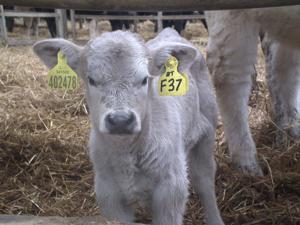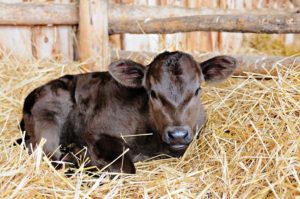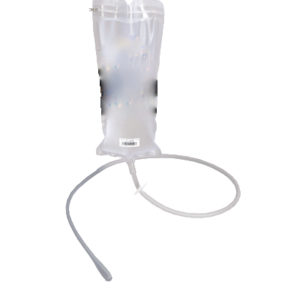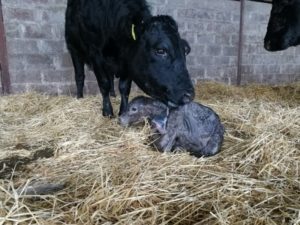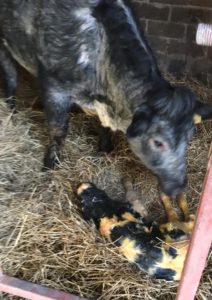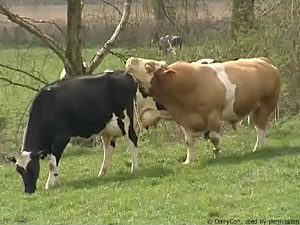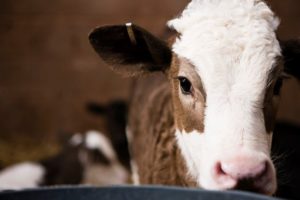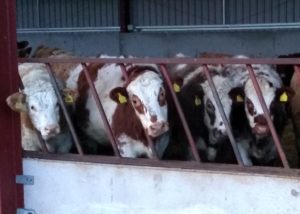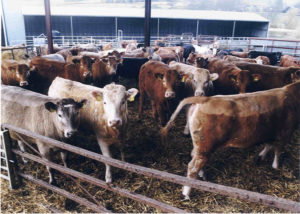Cow & Calf Management
Video: Calving Intervals
Fertility is a key driver of profitability for suckler herds and calving interval is a way of measuring fertility. Using MyHerdStats from ScotEID you can find out the average calving interval for your herd and the tag numbers of each cow falling within the calving interval cohorts listed for a particular timeframe. In this video Aberdeenshire farm vet Tim Geraghty gives an overview of the factors influencing calving interval and some of the changes you can make to improve your calving interval.
Video: Checking Heifers Pre-Breeding
Difficult calvings are a major drain on resources at calving time, both in terms of labour and finances. While completely eliminating dystocia in cattle is impossible, investing in a Pre-breeding check including a pelvic score will be a great help to ensure success going forward. In this video, Ross Wilson from Tinto Farm Vets talks us through the process of a pre-breeding check and explains the benefits it can bring you.
Video: Avoiding Accidental Pregnancies In Young Heifers
Every year we hear stories of unwanted pregnancies in heifer calves, an issue that creates a lot of work, cost and is a potential animal welfare issue. As we push for efficiency by increasing daily liveweight gains and also with a swing to more maternal breeds, the problem is likely to get worse. All producers should keep this issue in mind and take the necessary steps to reduce the risks on their farm. This short video highlights some of the options available to producers to minimise the chances of heifer calves becoming pregnant.
Calving Equipment Checklist
Are you ready for the start of calving?
Do you know where your calving ropes are?
Is your medicine cabinet well stocked?
With the first calf often arriving quicker than expected it’s a good idea to have checked that your calving equipment and essentials are ready for use. Read more>>
Disbudding Calves
Disbudding calves is a common management procedure on many beef and dairy farms. Horns pose as a potential welfare issue to cattle as well as being a potential safety risk to farmers. Read more>>
Caesarean Cows - Breed Again?
For those of you with cows that have had caesarean sections this spring, the question you may be asking yourself, is whether or not you rebreed these cows again. The likelihood of a cow getting back in calf after a caesarean is fairly high (with success rates measured on a case to case basis) depending on how well the procedure went and the cow receiving the right aftercare. Read more>>
Mob Grazing With Beef Cattle
Mob grazing with beef cattle can reduce housing cost, improve soil structure and improve pasture productivity long term. This New Entrants Factsheet gives an overview of what it involves and how to get started. Read more>>
Reflection On Calving 2020
With most farms now coming to the end of Spring calving 2020, now is a good time to reflect on calving. What has gone well? And where is there room for improvement? The main thing to focus on is where did losses occur? Read more>>
Maximising The Power Of Culling As A Management Tool
Culling cattle out the system is a powerful tool, not only to improve herd performance but also reduce the risk of any animal welfare breakdowns in your herd. There are many reasons for culling cattle, these may vary from farm to farm. However, the time to make culling decisions for breeding animals is restricted. Read more>>
How To Stomach Tube A Calf
Most cows will give birth to a calf without the need for assistance, likewise, most calves will get up and suckle from their mother of their own accord. However, the importance of getting good quality colostrum into the calf in the first few hours of birth cannot be over emphasised. With calves that are slow to stand or have a weak suckle reflex, you may need to intervene, in order to make sure the calf gets the colostrum it needs. Read more>>
Pre Breeding Checks
With calving just getting underway for many producers pre breeding checks on bulls and females may be the furthest thing from many people’s minds. However, by having a pre breeding examination carried out on breeding bulls up to 8 weeks before the bulls are due to go out with the cows you can save yourself the stress of finding out later that the bull was not fit for the job. Read more>>
Have You Got Enough Bedding?
The excessively wet winter means most of us will have problems turning stock out this spring due to the wet ground conditions. This will be particularly problematic for newborn calves and lambs where the combination of higher stocking rates, longer periods housed and warm weather will allow all the normal diseases to multiple rapidly. Obvious examples are scour, pneumonia, watery mouth, coccidiosis, etc. Read more>>
Colostrum - Are Your Calves Getting Enough?
Calves are born without any immunity and so failure to uptake adequate antibodies from colostrum will leave them at high risk of infections.
Calves with inadequate colostrum intake are 2.5 times more likely to die in the first four months of life. Read more>>
Calving Checklist
Pre Calving
- Regroup cows on expected calving date.
- Keep incalf heifers in a separate group.
- Assess your tag supplies and order more where necessary
Myostatins - What Are They and What Do They Mean For Your Herd?
Myostatin is a gene mutation that results in unregulated muscle growth or ‘double muscling’, most commonly seen in beef breeds such as British Blue and Limousin. There are nine variants of the mutation that occur in differing levels in different breeds. Read more>>
Checking Condition Of Spring Calving Suckler Cows
With winter rationing of cattle well underway, and calving just a couple of months away for some, the New Year is a good time to re-assess cow condition and make adjustments if necessary. Effective feeding management of suckler cows can only be achieved if we have starting points of cow condition score and forage analysis to manage feeding, without either of these there are a lot of unknowns and guesswork. Read more>>
Re-Clipping Cattle Backs
Clipping the backs of cattle at housing is common practice. However by the turn of the New Year quite often the hair has regrown to the extent that it can be difficult to tell if the animal was clipped or not. Benefits of clipping the backs of cattle when housed include; Read more>>
Caesarean Section In Cattle
The legacy of a great year for grass (in 2019) is an increasing number of cows likely to require a caesarean section. While a natural birth is the goal, when a section is required there are several things that are needed for a successful outcome. Read more>>
Body Condition Scoring Tips Amid Reports Of More Caesareans
The importance of managing body conditioning scores has been highlighted following reports of an increased number of caesarean sections in calving cows. Strong grass growth has led to more overly fit cows and, as a result, more difficult calvings. Read more>>
Tips For Transporting Livestock In Hot Weather
During a spell of hot weather the threat to animal welfare is a risk during transport. The following tips will help to protect animals from the stress of transportation during hot and humid weather. Read more>>
Making A Note Of Which Cows Run With Which Bull
With cattle turnout taking place across the country, it’s worth remembering to make a note of which cows go out to grass with which bulls.
For those in the Beef Efficiency Scheme this may already be common practice seeing as the sire of each calf needs to be recorded as part of the scheme. There are several advantages to knowing the sire of your calves; Read more>>
Are You Prepared For Calving?
With calving looming or already started for some this is the time to make sure that you’re prepared for what can be the busiest and most stressful part of the year. With the first calf often arriving quicker than planned it’s a good idea to have checked that your calving equipment and essentials are ready. Read more>>
Save Straw and Help Muscle Tone In Spring Calving Beef Herds
With wintery weather and hard frosts looking likely for the next month those with stubble fields (providing there is some shelter) may want to consider turning out the fittest spring calving cows for a while. Those overfat cows would benefit from increased muscle toning outside while being fed via ring feeders and it also saves straw. If the weather turns mild and ground conditions suffer, simply bring them back in again. Similarly remember to bring in those nearest calving or have them on the pre-calving diet 8-weeks prior. Read more>>
Last Minute Winter Suckler Checks
Thin cows are more likely to have a slower calving, poorer quality colostrum, start cycling later, and a longer calving interval. The knock on detrimental impact on in-year calf weight gain, cheap calf weight gain at grass, weaning weights, and resulting barren rates in the following year(s). Read more>>
Clipping The Backs Of Cattle
Clipping the backs of cattle at the point of housing is for most now a common practice to reduce sweating and the risk of pneumonia. Trying to keep cattle cool as weight gains increase is a particular problem facing those with fattening cattle. So would it not be beneficial to re-clip cattle again mid winter? Read more>>
Warning: Heat Stress, Beef Cows
The bovine thermal comfort zone is -13oC to +25oC. Above this upper level, cattle will start to suffer some degree of heat stress. Cattle naturally minimise exertion to stay cool. High temperatures will also have some effect on sperm quality and even embryo viability – each of these being hugely important in the middle of the main beef-breeding season. Read more>>
Protect Body Condition
The team is now having numerous conversations about keeping milk on cows and eking forage stocks out until grazing. Cashflow, locally available feeds, and capacity to handle different feeds on farm all come into play – meaning there is no single answer. But please do get in contact with your local consultant and nutritionist. Read more>>
Maximising Calf Survival
With calving time starting it would be worth considering what could be implemented to maximise the survival rate of new born calves. Calf losses can be significant not just at calving but in their first three weeks of life. Nobody wants to put all that effort in to lose them. The better conditions are for young calves at calving, the better survival rates will be. Read more>>
Why Do We Calve At 3 Years?
A major reason why heifers are still calved at 3 years old is that when selecting heifers (approximately 10 months before they would start calving) we think they are not big enough at 15 months to “make cows”. We forget the growth they will put on in the following 300 days. Read more>>
A Dry Lie For Calves
If spring is delaying the turnout of newly calved cows, remember to create a dedicated creep area and, despite its cost, do not scrimp on straw for newly born calves. Read more>>
Sign up to the FAS newsletter
Receive updates on news, events and publications from Scotland’s Farm Advisory Service




